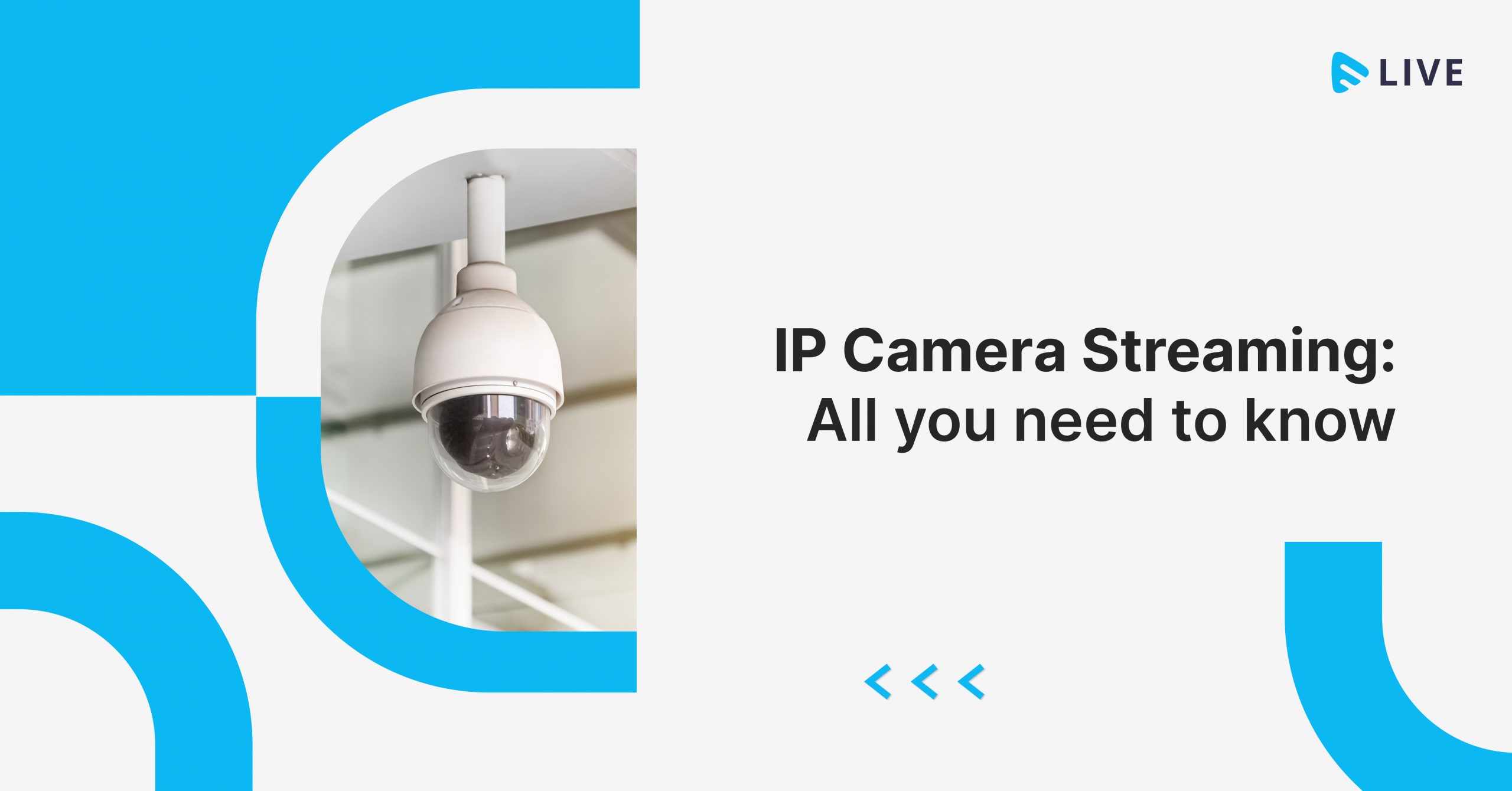IP camera streaming has garnered high popularity over the past decade. This surge in popularity can be attributed to its ability to deliver high-quality video capture, facilitate effortless installation, ensure robust security protocols, and maintain high compatibility with a wide array of systems and applications.
Furthermore, these IP cameras have garnered admiration for their exceptional versatility, making them easily integratable with a diverse range of applications, systems, and solutions.
The origins of IP camera streaming can be traced back to the visionary efforts of Axis Communications in 1996, who pioneered this technology to revolutionize live video streaming. Since its inception, IP camera streaming has found widespread adoption across various sectors, including government buildings, industrial facilities, traffic intersections, corporate offices, apartment complexes, and numerous others.
However, its reach extends far beyond these conventional applications, as IP camera streaming has evolved to serve a multitude of innovative use cases. These include facilitating virtual classrooms, providing continuous streaming of natural landscapes and environmental settings, covering live events, and fulfilling numerous other creative purposes.
Whether you are actively involved in the streaming industry or merely a curious observer, it is imperative to acquire a fundamental understanding of IP camera streaming. This knowledge encompasses comprehending its inherent advantages, delving into the detailed workings of the technology, and exploring the diverse applications that make it an indispensable tool in the modern world.
So, let’s get started!
What Is IP Camera Streaming?
IP camera streaming represents a dynamic and influential facet of modern digital technology, showcasing the seamless integration of video streaming capabilities through Internet Protocol or IP cameras.
This innovative process harnesses the power of IP cameras to transmit live video content over IP networks, enabling real-time viewing from an array of devices and platforms. The linchpin of this sophisticated streaming mechanism is the Real-Time Streaming Protocol, a foundational protocol that plays a pivotal role in facilitating the streaming experience.
RTSP functions as the conduit through which live video content from IP cameras is seamlessly conveyed to viewers across diverse devices and platforms. This protocol serves as the cornerstone of IP camera streaming, orchestrating the transfer of live video feeds from the IP camera to a central hub known as a Network Video Recorder. The NVR plays a vital role in the aggregation and management of the video streams, ensuring the delivery of high-quality, real-time video content to the intended audience.
How Does IP Camera Streaming Work?
IP camera streaming leverages the power of digital technology to transmit live video content over various internet and data connections, including WiFi, Ethernet, USB, and more. Unlike traditional analog cameras, IP cameras are equipped with the inherent ability to capture digital video content and seamlessly transmit it over network connections.
To comprehend how IP camera streaming functions, it’s essential to delve into the underlying mechanics of these advanced devices.
- Digital Transmission: The hallmark of IP cameras is their capability to transmit digital video content. This implies that the video captured by the camera is immediately converted into digital format, making it suitable for transmission over an internet/data connection. This is in stark contrast to analog cameras, which produce analog signals that require additional conversion for digital transmission.
- Network Connectivity: IP cameras are networked devices, and they connect to the network in a manner similar to other network peripherals like printers or scanners. They integrate seamlessly into existing networks, whether via wired connections such as Ethernet cables or wireless connections like WiFi.
- Storage and Streaming Options: IP cameras offer flexibility in terms of data handling. Depending on their design and purpose, they can save captured footage to an onboard memory source, link to external storage devices on the network, or stream live video content directly to the internet. This adaptability makes them suitable for various applications, from home security to professional surveillance.
- Decentralized vs. Centralized Cameras: IP cameras come in two primary configurations. Decentralized network cameras possess their control interface and storage media, allowing them to operate independently. In contrast, centralized network cameras rely on a Network Video Recorder for video storage and management. An NVR is a specialized program or device that collects and stores footage from multiple network cameras, offering centralized remote viewing capabilities.
- NVR Functionality: An NVR operates similarly to a Digital Video Recorder but with a distinct difference. While a DVR encodes and processes footage from connected cameras, an NVR relies on IP cameras to encode their video streams. This approach streamlines the process and enables efficient centralized remote viewing of multiple cameras simultaneously, making it particularly suitable for surveillance applications.
- Hybrid Systems: Some systems offer the flexibility of hybrid solutions, which can accommodate both IP cameras and traditional analog cameras. This versatility allows for the integration of existing surveillance infrastructure with modern IP camera technology.
- Network Connectivity Options: IP cameras can connect to networks through various means. Ethernet cables e.g., RJ45, CAT5, CAT6, provide the fastest and most secure connection, minimizing the risk of signal interception and interference.
Wireless networks, facilitated by WiFi routers, offer convenience but may compromise security if not properly encrypted. Additionally, cellular network connections are the most secure but may come at a higher cost, especially for high-definition video delivery.

A Technical Breakdown of IP Camera Streaming
IP camera streaming involves a complex interplay of hardware and software components to transmit live video over IP networks. Below, we’ll delve into the technical process, breaking it down into key steps:
1. Video Capture and Compression:
- Sensor and Lens: The process begins with the IP camera’s image sensor and lens capturing the scene. The sensor converts light into electrical signals, while the lens focuses the image.
- Digitalization: The analog electrical signals are then digitized into a digital video stream, consisting of individual frames.
2. Video Encoding:
- Codec: The digital video stream undergoes encoding using a video codec such as H.264 or H.265. This codec compresses the video data, reducing its size for efficient transmission.
- Compression Algorithms: The codec employs complex compression algorithms to eliminate redundant or less perceptible visual information while retaining essential image details. This compression minimizes the bandwidth required for transmission.
3. Network Communication:
- IP Address Assignment: Each IP camera is assigned a unique IP address, allowing it to communicate over the network. This can be done statically or dynamically through protocols like DHCP.
- Real-Time Streaming Protocol or RTSP: RTSP plays a pivotal role in IP camera streaming. It establishes a connection between the camera and a client device, enabling real-time video streaming. RTSP operates over Transmission Control Protocol or TCP or User Datagram Protocol or UDP to ensure reliable data delivery.
4. Data Transmission:
- Packetization: The compressed video stream is divided into packets for transmission. Each packet contains a portion of the video data along with header information specifying its destination and sequencing.
- Transmission Medium: The choice of a wired or Ethernet, or wireless like WiFi medium depends on the camera’s connectivity. Ethernet provides a reliable and stable connection, while WiFi offers mobility.
5. Network Video Recorder or NVR:
- Centralized Storage: In centralized IP camera systems, NVRs act as central hubs for video storage and management. The NVR receives video streams from multiple IP cameras, decodes and stores the data.
- Video Management Software: NVRs run specialized video management software that allows users to access, view, and manage multiple camera feeds simultaneously.
- Remote Access: NVRs enable remote access to live and recorded video feeds, often via web interfaces or dedicated applications. This facilitates real-time monitoring and playback from anywhere with network connectivity.
6. Viewer Interaction:
- Client Devices: Viewer devices, such as computers, smartphones, or tablets, connect to the IP camera or NVR through client applications.
- Protocol Support: These client applications use protocols like HTTP, RTSP, or ONVIF to request and display live video streams.
- User Controls: Users can interact with the camera, controlling functions such as pan, tilt, zoom, and video recording through the client interface.
Advantages of IP Camera Streaming
IP camera streaming boasts a plethora of advantages, making it a compelling choice for a wide range of applications. Let’s explore these advantages in greater detail:
1. Simplified Video Streaming
- Integration of Camera and Encoder: IP camera streaming offers a streamlined solution by integrating the camera and encoder functions into a single device. This simplification eliminates the need to grapple with the complexities of separate technical processes, including video encoding, distribution, and workflow management.
- Effortless Workflow: Users benefit from a simplified workflow that minimizes the intricacies typically associated with video streaming. The IP camera’s built-in capabilities ensure a user-friendly experience, including automatic transcoding for optimal video quality.
2. Robust Security Measures
- Encrypted Video Streaming: Security stands as a paramount advantage of IP camera streaming. It incorporates robust encryption mechanisms to safeguard the integrity and confidentiality of video streams, shielding them from unauthorized access or tampering.
- Authentication and Password Protection: Advanced authentication methods and password protection mechanisms fortify the security of IP camera streams. These measures ensure that only authorized individuals can access and control the camera. To enhance the security measures and ensure privacy for your streaming activities, consider using ExpressVPN Chrome extension. This can secure your internet connection while maintaining high-quality video delivery.
- IP Address Blocking: IP cameras empower users to enhance security by blocking specific IP addresses, preventing unwanted intrusion or access attempts.
- Permission Control: The platform offers granular control over permissions, enabling users to regulate who can publish content to their server, reinforcing content security. Integrating gun detection AI technology with IP camera systems can further boost public safety by enabling real-time identification and alerts in high-risk environments.
3. Superior Quality and Reliability
- High-Quality Video: Quality is paramount in video streaming, and IP camera streaming excels in this aspect. It guarantees viewers a seamless experience with high-quality video content delivered to their devices.
- Optimized Bandwidth Utilization: IP camera streaming optimizes bandwidth usage, ensuring efficient data transmission without causing congestion or network bottlenecks. This results in a lag-free and smooth streaming experience regardless of the viewer’s device or platform.
4. Cost-Effectiveness
- Affordable Solutions: IP camera streaming stands out as a cost-effective choice, catering to a diverse spectrum of streamers, from beginners to advanced users. It allows content creators to offer top-notch video content to their viewers without breaking the bank.
- Utilization of PTZ Functionality: Many IP cameras are equipped with Pan-Tilt-Zoom or PTZ functionality. IP camera streaming harnesses this feature, enabling seamless switching between cameras to deliver industry-grade video streaming solutions without the need for expensive hardware or setups.
5. High Scalability and Flexibility
- Scalable Architecture: IP camera streaming systems can be easily scaled to accommodate changing requirements. Additional cameras can be integrated into the network without extensive modifications, making it adaptable for various environments and use cases.
- Multi-Platform Compatibility: IP camera streaming is compatible with a wide array of devices and platforms, offering viewers the flexibility to access streams on their preferred devices, be it computers, smartphones, or tablets.
The Bottom Line
Undoubtedly, IP camera streaming has gained significant prominence in recent years, primarily due to its multifaceted advantages and cost-effectiveness. The insights provided above aim to enhance your understanding of this technology and explain its potential for your video streaming endeavors. Nevertheless, prudent planning of your video streaming strategy and budget is strongly advised before arriving at a decision.
If you are in search of a competitive live streaming platform that can meet your diverse needs, consider exploring Muvi Live. This platform not only offers seamless live streaming solutions tailored to accommodate viewers across various devices and platforms but also provides a comprehensive array of professional live streaming features. These include a built-in scalable Content Delivery Network or CDN, live stream recording capabilities, DVR-enabled live streaming, video library management, and detailed analytics and reports, among others.
To delve deeper into the possibilities that Muvi Live can offer, start for free today.
















Add your comment